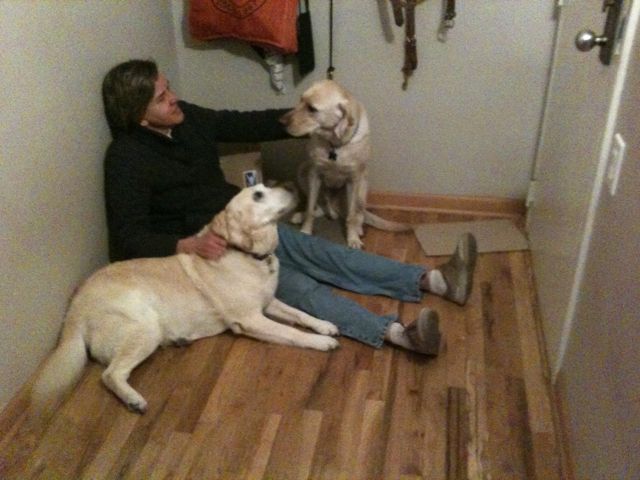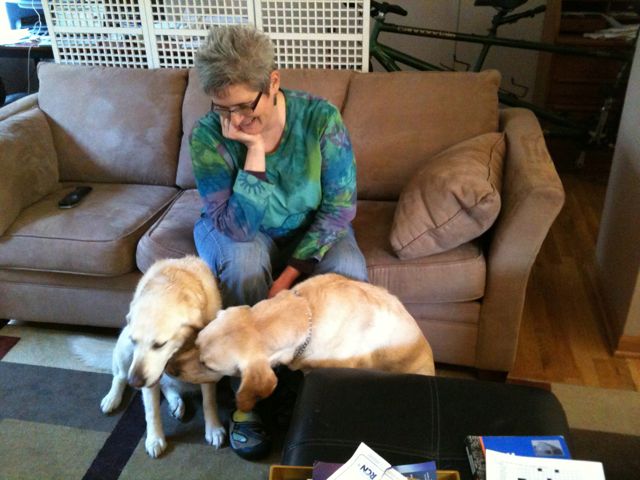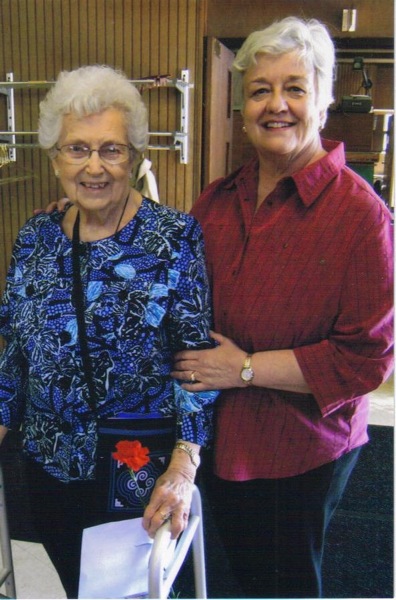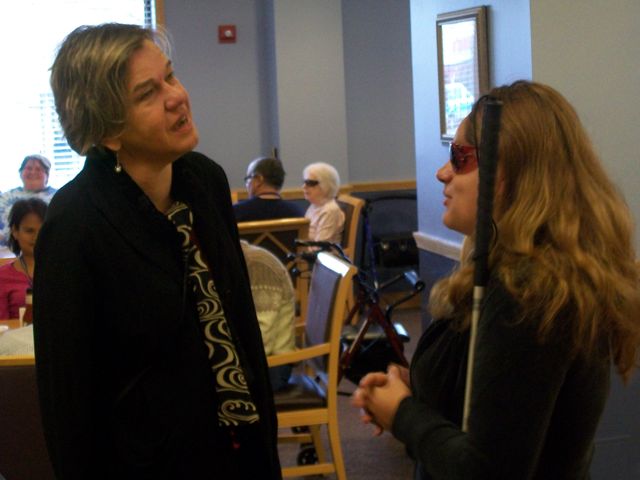Smiling dogs
November 4, 2011 • 3 Comments • Posted in Beth Finke, Blogroll, Uncategorized, writing, Writing for ChildrenWhile preparing my essay for Chicago Public Radio this week I decided to send something about Harper’s early retirement to Bark magazine, too. They liked what I wrote and published When a Seeing Eye Dog Gets Off-Track as a guest post on the Bark blog last Tuesday.
The post I wrote for Bark is similar to what I’ve been writing here, but you might want to link to it anyway just to admire the photograph they published along with it –it’s another photo taken by my friend Mary Ivory. Mary is a licensed clinical professional counselor, social worker, life coach, and from all accounts, a very talented photographer. She took the photograph on the book jacket flap of Hanni and Beth: Safe & Sound, and when I phoned her earlier this week to ask if she could take a last-minute photo of Harper and me for the Bark blog, she came in, ahem, a flash.
Having work published in Bark puts Mary and me in some darned good company: the magazine’s impeccable pedigree includes publishing many of today’s most acclaimed authors including Ann Patchett, Augusten Burroughs, Rick Bass, Amy Hempel, and Pulitzer Prize winning poet Mary Oliver. Bark has been honored with an Award of Merit from The Society of Publication Designers, and their photo book DogJoy features the magazine’s popular “Smiling Dogs” submissions. from their web site:
Bark is the magazine of modern dog culture—it speaks to the serious dog enthusiast. Bark is the indispensable guide to life with dogs, showing readers how to live smartly and rewardingly with their canine companions. Founded in 1997, as a newsletter to advocate for off-leash dog parks in Berkeley, California, the magazine quickly grew into a glossy, award-winning publication acclaimed for its timely commentary and rich literary offerings. Today, Bark has a nationwide readership of over 250,000.
In addition to regular guest Bark blog posts,I’ve had a few stories published in the four-color “glossy, award-winning” version of Bark, too. It’s always a thrill to be contacted by their staff — it gives me the opportunity to brag that I write for the same magazine Ann Patchett writes for. And now Mary Ivory can brag, too. Her photography has been published by the same folks who honor photographs of “Smiling Dogs” in every issue.
Be careful out there
November 1, 2011 • 21 Comments • Posted in Beth Finke, blindness, guide dogs, radio, Seeing Eye dogs, Uncategorized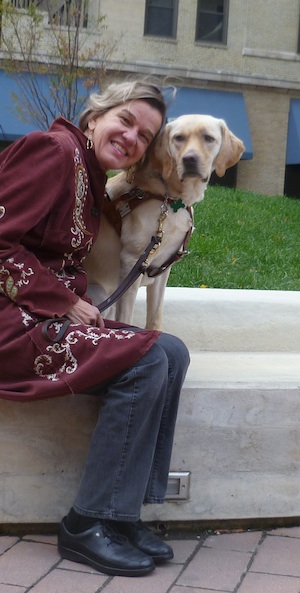
There's our boy with me at the park just outside our place. Gonna' miss him, but he'll be happy in peaceful surroundings. (Photo by Mary Ivory)
Harper and I head to the Chicago Public Radio studios on Navy Pier tomorrow to record an essay about his early retirement. Plenty of CTA buses go from our neighborhood to Navy Pier, but ever since my Seeing Eye dog was clipped by a car last Spring, he’s afraid to take me across the street to the bus stop. We’ll be taking a cab.
An organization called Transportation for America reports that a pedestrian in America is hit by a vehicle every seven minutes. Our friend Dean Fischer was one of those statistics – he suffered a major shoulder injury after getting hit from behind while crossing at Jackson in downtown Chicago. Staff at Northwestern’s emergency room told Dean that they take care of seven or eight people a day who’ve been hit by cars.
Cell phones weren’t around back in the dark ages (hmm, in my case I probably oughta refer to them as “light” ages…!) when I was still able to get behind the wheel. I can only imagine how tempting it must be to send a quick text or answer a phone call while on the road. I’m hoping that Harper’s story might encourage drivers to think twice about that, though.
Harper moves to his retirement home this weekend. I dread saying goodbye to him, so I focus instead on the trips we’re taking during our last few days together. We’ll have fun in the Chicago Public Radio studio tomorrow, and if any good can come of my gentle sweet two-year-old Yellow Lab’s early retirement, maybe it will be to convince radio listeners who hear it to put their phones away, keep their eyes on the road and prevent one more two-footed or four-footed creature from getting hurt.
The truth about Middle Child Syndrome
October 28, 2011 • 23 Comments • Posted in blindness, book tour, Flo, travel, Uncategorized, visiting libraries, visiting schoolsWe had such fun with my sister Cheryl on our train ride to visit her daughter Caren and her family in Minnesota last year that she agreed to ride on the Texas Eagle with us to Springfield, Ill. Today.
I’m pretty sure Harper will do alright on this trip (he guides well inside train stations and hotels, it’s walking along sidewalks and crossing intersections that freaks him out) but it is oh so reassuring to know that my big sister Cheryl will be along to guide me, too. Cheryl has always had a way of boosting my confidence, and we always, always have fun together.
I grew up the youngest of seven children. Cheryl is fourth in line, and this explanation of middle child syndrome describes her perfectly:
Many times they go in the opposite direction of their oldest sibling to carve out their own place of achievement and relish in the satisfaction of being capable of doing it on their own. They are sensitive to injustices and much less self-centered than their siblings (first born and last born), which allows them to maintain successful relationships. They are put in the position to learn social skills that are extremely useful, not only within their household, but within their social community.
We were invited to Springfield by the Illinois School Library Media Association (ISLMA) to attend the Author Breakfast at their annual convention. The way I understand it, Illinois authors do a sort of speed-dating thing during breakfast: we sit at one table for a short time to describe our books, then hustle over to the next table for a short time to describe our books, then to the next table and so on. The idea is to make such a good impression on the school librarians that they’ll ask for a “second date” and invite us to their school to do a presentation sometime.
I will not be at all surprised if we get to the hotel tonight and Cheryl recognizes someone she knows in the lobby. Any time I am in a crowd with Cheryl and she sees someone that maybe just kind of sort of looks familiar, she does what any other self-respecting middle child would do: she approaches them and introduces herself. And if they don’t happen to be the people she thought they were, Her warm smile and friendly greeting wins them over, and she’s made a new friend. Its amazing.
And really, Cheryl is amazing. She was a teenager when our dad died, waitressed at Mario’s through high school and helped Flo raise we three younger ones. After she got married, she stayed in Elmhurst, our home town, and her house became a second home to us. She and her husband Rich raised three terrific kids, and now they have ten beautiful grandchildren. Cheryl is Flo’s caretaker, keeping track of her schedule and escorting her to all of her doctor visits.
And with all that going on (or maybe because all of that is going on?!) she’s agreed to this quick getaway with Harper and me, too. The quintessential last born self-centered youngest sister doesn’t say it nearly enough, but I really do appreciate everything Cheryl has done — and continues to do — for me. Once we’re “all aboard” I’m going to have her join Harper and me (and all the people she will recognize or meet!) in the club car for a toast. Here’s to Cheryl, and to all the other middle children I love so much. Cheers!
Her specialty is risotto
October 25, 2011 • 15 Comments • Posted in blindness, book tour, careers/jobs for people who are blind, Uncategorized, writingAnd, oh yeah. Laura Martinez just happens to be blind.
In her spare time (!) Laura teaches a cooking class at Friedman Place, a non-profit Supportive Living Community for Chicago adults who are blind and visually impaired. Laura doesn’t live at Friedman Place, but she was there last Thursday when I visited to give a presentation about my writing life. The Friedman Place web site promotes the full range of services and activities they provide “so that residents’ days are healthy, dignified, and stimulating.” While I am confident Laura’s cooking class keeps Friedman Place residents dignified and stimulated, I can’t vouch for the “healthy” bit: she served her signature brownies to residents during my presentation, and the luscious chocolaty treats were downright sinful!
I had a chance to talk with Laura before she skedaddled to her day job, and she told me co-workers on the line at Charlie Trotter’s have become comfortable having her there prepping, cleaning and chopping the food. I asked if she had a specialty. “Well, a lot of vegetarians come to Charlie Trotter’s,” she said,her voice betraying a proud smile. “They like my vegetable risotto.”
Renowned Chicago chef Charlie Trotter first met Laura a few years ago during a visit to the Chicago Lighthouse for the Blind. Laura had been working in the Lighthouse cafeteria kitchen at the time, and it was love at first taste. Charlie is quoted in an article in the Chicago Tribune about Laura:
“I was watching her work and saw how she handled things with her hands, touching for temperature and doneness, and I ate her food and it was quite delicious. We got to talking and she told me about her dreams and I said, ‘What would you think about working at Charlie Trotter’s?'”
Laura was still attending the prestigious Le Cordon Bleu culinary program at the Cooking and Hospitality Institute of Chicago at the time. Charlie Trotter offered to help with her tuition, and Laura has been working for him ever since.
The staff and residents at Friedman Place absolutely gushed over the presentation I gave with Harper last Thursday, so many of them shaking my hand and encouraging me to return with my new dog next year. I am flattered, of course, but I’m not fooling myself: I’m pretty sure they think they’ll get Laura’s brownies again if I come back.
